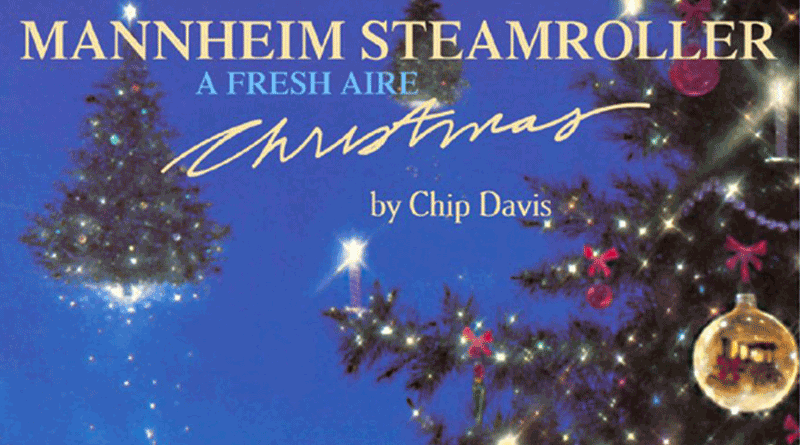Finding The Good Mannheim Steamroller: A Fresh Aire Christmas

Okay! I’m doing it! Finally!
My first Christmas season here in Colorado, I wrote up a review (an apologetic, really) of Mannheim Steamroller’s first album. Ever since then, I’ve wanted to return and reviewing the other four albums.
Today is the day! Well, for the next one, at least.
Here’s the thesis: Mannheim Steamroller’s Christmas music is great when it’s using actual musicians on instruments you don’t have to plug in. When they find the piece and the period instruments and the musicians who love it enough to play it like it matters, then we’re treated to something truly special.
That thesis is amply evidenced by Mannheim Steamroller’s second album, A Fresh Aire Christmas (it appears they got smart by naming their album something significantly more aligned with the Fresh Aire brand than their previous album, Christmas).
This album dropped 4 years after their previous album and offers some wonderful moments. We’ll take a look at each number as it appears in the album.
NOTE: If you’re reading this in e-mail, you’ll need to click through to hear the audio clips.
Hark the Herald Trumpets Sing
Mercifully, this album forgoes the synth-heavy opening of its older sibling and just puts a brass and percussion sections in front of some (overly stereoed) mics.
It’s a classic fan fair (fanfaire?) that doesn’t do much for me (I think it’s that the brass is a little overplayed), but it’s a fan fair; it’s supposed to be bombastic and triumphal.
Plus, it’s set up for the return to the 80s.
Hark the Herald Angels Sing
With a youthful vigor that flagrantly returns to the synths of its father’s (like a dog to its vomit), the keyboard is back. And with a trumpet patch so cheesy it makes residents of Wisconsin go, “Whoa, man, easy does it.”
But there is a nice back and forth between the old school and the “new” school as the synth brass takes the melody and is countered by an actual brass section. Seen that way, you can either take it as a wonderful fusion of musical technology or as graffiti on our western heritage.
I’m still not sure where I come down.
Fortunately, I don’t have to think about it too long, because the indulgence ends after three-and-a-half minutes and moves on to the real magic.
Veni, Veni (O Come, Come Emmanuel)
What I most appreciate about Mannheim Steamroller is that they just get it. Every artist with more than one album has a Christmas album. The never-satisfied God Of Novelty has his talons in the back of all our talents and so we end up with the most brutal musical carnage to ever hit the American airwaves.
Yes, Rebecca St. James, I’m looking at you.
I mean, I don’t mind if an artiest wants to write something totally awful to pay homage to the long line of awful that plays in the mall. Go for it. Just leave the history-rich material to people who will care about it.
Like Chip Davis and crew.
Veni, Veni demonstrates what this literacy looks like in action. Veni, Veni, commonly known as “Oh Come, Oh Come, Emmanuel”, is a text that dates back to the 8th century and a melody that goes back to the 15th century.
But that’s not where I fell in love with it.
Every time I hear this song, I’m transported back to my parents living room, where the advent candles (one for each day) stood lit and we sang this psalm in unison (Thanks Mom). In my opinion, that’s the only way to perform Veni Veni: a plain-song mystically trenched in ancient paths.
To hear Mannheim Steamroller express it, I find that same reverence.
Appropriately, the number begins with a unison, male vocal introduction and a clear church bell ring, a fitting call to the monastic.
After the opening stanza, the higher voices take it, again in unison, joined by a block chords accompaniment.
All of that is a respectful tribute to this ancient text and medieval melody. But what happens next is magical.
If you’ve ever performed this piece, you know how much rubatto there is. Technically, it’s in 4/4, but everybody takes their time and just goes with what feels good. When the Mannheim Steamroller version pivots to a more metronomical verse, it doesn’t go with a 4/4 time signature; it moves to 6/8 and then plays the melody over it in a hemiola
That’s genius.
As if it weren’t enough, this fresh-yet-reverent juxtaposition of melody and accompaniment is then filled out by a feminine choir:
This is not just good Mannheim Steamroller, this is great Mannheim Steamroller.
Most importantly, it’s good Mannheim Steamroller that actually airs on the radio.
I know that most of my complaint about the good Mannheim steamroller is that I never surfaces in the popular consciousness. This is a (if not the) exception to the rule. And just to show how fickle I am, that’s actually a little disappointing. I love this arrangement and I really hate to hear it played as background music at a Safeway. But, I guess I can’t have my snobby cake and eat it, too.
The Holly and the Ivy
Usually, after such a stellar performance, the album gives us something wantonly dreadful. Like 80s-local-car-dealership-commercial dreadful. That’s coming, but there’s just enough class left to give us a well played recorder solo:
While we’re on the subject, new rule: no more giving five-year-olds plastic recorders and expecting them to do anything other than treat it like traffic whistle. It’s so disrespectful to relegate such a beautiful instrument to the toy bin. The recorder can be exquisite when played properly and, with enough practice, you can really puff on it like a boss. If you haven’t had a chance to hear a recorder choir in concert, do it. You can thank me later. The same goes for flute choirs. Good flute choirs, that is. I mean bad flute playing is just…wow.
Anyway, the properly played recorder introduces the melody and is joined by two wonderfully matched classical guitars. The lush, string orchestra blooms under them and then the recorder is back, joined by some tasteful (if perhaps unnecessary) synthesizer.
All together, it’s a delightful arrangement for a delightful little tune.
Little Drummer Boy
Two tracks of thoughtful, historically-sensitive covers and then they toss it all away.
We can’t hope for too much.
I would just love to crucify them for this track, but I have to be honest and say that digital sequencing was just becoming popular. This track is a clear example of layering percussive tracks on top of each other –a process the equipment was designed for. That makes for an interesting ending.
To gain any appreciation for this track, you can’t listen to the song as a whole, you have to listen to each new instrument that is added and the watch them all drop out in turn. That’s pretty common place now, but at the time, it was pretty innovative.
Plus, in the liner notes, Chip Davis explains he was illustrating a toy drummer boy. This piece nicely captures that imagery.
Still, Still, Still
So I’m a sucker for this one.
It starts with some keyboards duking it out for most busy counter melody:
But then it’s all made better by the marmalade choral melody that manages to rise above it:
Low How A Rose E’re Blooming
The brass are back:
That aren’t over-blowing their horns (contra the opening number), but there is regal pomp to it and an authentic instrumentation that stands alone on the album.
If you like brass ensembles, this will deliver. And there’s a little fugue that takes it to the end. I can’t shake the feeling that the piece gets away from the performers a bit.
In Dulci Jubiolo
I like early music. And if you like early music, you’re going love this:
If you don’t like early music, then, yeah, that was really obnoxious.
But you have to love some string quartet and recorder.
It’s a fun number. And since the “fun” numbers usually involve quite a bit of synthesizer with 80s patches, I’ll take a nice little ditty from some talented, acoustic performers.
Greensleeves
Staying with our renascence players, we turn to Greensleeves.
The strings come back (ala Vaughn Williams) and walk us through the familiar tune.
Then the early musicians are back to continue their recitation.
It finishes with the whole orchestra together.
It’s a wonderfully authentic and tasteful take on the song and a cogent exemplar of our thesis: Mannheim Steamroller is great when they unplug.
Carol of the Bells
There are only three acceptable ways to perform Carol of the Bells: With actual bells, an actual choir, or actual bells with an actual choir, like the the Mormons. I love the Mormons.
Mannheim Steamroller ignore this rule and opts for their best impersonation of the Trans Siberian Orchestra, a cover so lousy that I thought about buying it, but opted instead to by three cans of baked beans and figured I could re-produce the number myself.
Oh, kill me now.
But there are two interesting moments in this arrangement. Firstly, there’s a pretty cool brass lick (making their third appearance here):
And then this fantastic bit of digital sequencing:
So, part of me wants to submit this artifact as an interesting exception to the rule. The other part of me wants to slap Chip Davis’s hand and say, “Stop it! Stop it right now!”
Traditions of Christmas
This original melody (carried wonderfully by the oboe), is just nice.
But my favorite thing about this piece is the liner note by Chip Davis:
As many of you who are on our mailing list know, the album was chosen by the fans, through sending in request postcards. I had toyed with writing a Christmas carol myself anyways, but when the votes came in, to my surprise, I only got one vote so…why do an original? I felt so sorry for myself, i decided to do it for that one person. This is all about a fuzzy warm sweaters, soft images of the tree, cookies in the oven on Christmas morning and family.
#PoorChipDavis
Cantique de Noel (O Holy Night)
O Holy Night is one of my favorite Christmas carols. Sadly, it’s mostly spat on by every singer who feels the need to over emote all of it (or every idiot who thinks that Worst Recording Ever is still funny).
Mannheim Steamroller is not the exception.
The piano/synth performances is way too percussive (Davis says he was trying to channel Beethoven).
But if you can listen past that, there are wonderfully lyrical performances by the the (musted) violin and the Oboe.
Things smooth out in the last two minutes and it finishes on a gentler note. The (unmuted) violin takes us to the end.
For an ensemble known for extreme instrumentation, either digitally or acoustically, I love that they end it with a simple, lonely piano line. A very fitting in to their second album.
Conclusion
So we get to the end of Chip Davis’s second installment of Christmas music. Once again our thesis is proven: Mannheim Steamroller’s Christmas music is great when it’s using actual musicians on instruments you don’t have to plug in.
I like Mannheim Steamroller. Yes, it can be indulgent, yes it can stray too much into it’s own time and cleverness, but when you take all of that away, I find a love for the material that shines through.
Merry Christmas everyone!

Member discussion